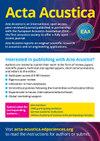模拟双侧人工耳蜗使用者空间听力的模型框架
IF 1.4
3区 物理与天体物理
Q4 ACOUSTICS
引用次数: 0
摘要
双侧人工耳蜗(CIs)可显著提高双侧人工耳蜗使用者的空间听力敏度,但与正常听力者相比仍存在较大差距。例如,CI用户的定位技能较差,很少或根本没有双耳掩码,并且掩码的空间释放减少。多种因素已经确定限制双耳听力与CIs。这包括不同声音处理阶段导致的信号退化、电极-神经元界面的活力、脑干神经元受损以及不同皮质层之间连通性的退化。为了帮助量化这些因素之间的相对重要性和相互关系,可以而且应该采用计算机模型。虽然探索单个阶段的模型通常与选定的实验数据非常一致,但它们的组合通常不能产生全面而准确的感知模拟。在这里,我们将来自CI声音处理的信息与计算听觉模型阶段结合在一个模块化和开源框架中,类似于人工双边CI用户。主要阶段是(a)双耳信号生成与可选的头部相关脉冲响应滤波,(b)不限于特定制造商的通用CI声音处理,(c)电极到神经元的传递,(d)双耳交互,(e)决策模型。通过局部化实验实例,说明了不同模型阶段的功能和输出。然而,模型框架并不是为特定的数据集量身定制的。它提供了一系列合理的编码策略,并允许第三方模型扩展或替换;因此,可以将该模型用于广泛的双耳应用,甚至用于教育目的。本文章由计算机程序翻译,如有差异,请以英文原文为准。
A model framework for simulating spatial hearing of bilateral cochlear implant users
Bilateral cochlear implants (CIs) greatly improve spatial hearing acuity for CI users, but substantial gaps still exist compared to normal-hearing listeners. For example, CI users have poorer localization skills, little or no binaural unmasking, and reduced spatial release from masking. Multiple factors have been identified that limit binaural hearing with CIs. These include degradation of cues due to the various sound processing stages, the viability of the electrode-neuron interface, impaired brainstem neurons, and deterioration in connectivity between different cortical layers. To help quantify the relative importance and inter-relationship between these factors, computer models can and arguably should be employed. While models exploring single stages are often in good agreement with selected experimental data, their combination often does not yield a comprehensive and accurate simulation of perception. Here, we combine information from CI sound processing with computational auditory model stages in a modular and open-source framework, resembling an artificial bilateral CI user. The main stages are (a) binaural signal generation with optional head-related impulse response filtering, (b) generic CI sound processing not restricted to a specific manufacturer, (c) electrode-to-neuron transmission, (d) binaural interaction, and (e) a decision model. The function and the outputs of different model stages are demonstrated with examples of localization experiments. However, the model framework is not tailored to a specific dataset. It offers a selection of sound coding strategies and allows for third-party model extensions or substitutions; thus, it is possible to employ the model for a wide range of binaural applications and even for educational purposes.
求助全文
通过发布文献求助,成功后即可免费获取论文全文。
去求助
来源期刊

Acta Acustica
ACOUSTICS-
CiteScore
2.80
自引率
21.40%
发文量
0
审稿时长
12 weeks
期刊介绍:
Acta Acustica, the Journal of the European Acoustics Association (EAA).
After the publication of its Journal Acta Acustica from 1993 to 1995, the EAA published Acta Acustica united with Acustica from 1996 to 2019. From 2020, the EAA decided to publish a journal in full Open Access. See Article Processing charges.
Acta Acustica reports on original scientific research in acoustics and on engineering applications. The journal considers review papers, scientific papers, technical and applied papers, short communications, letters to the editor. From time to time, special issues and review articles are also published. For book reviews or doctoral thesis abstracts, please contact the Editor in Chief.
 求助内容:
求助内容: 应助结果提醒方式:
应助结果提醒方式:


